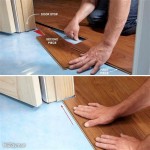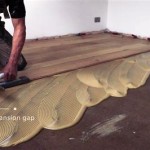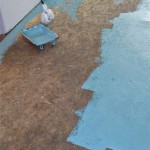Laying Laminate Flooring Over Particle Board: A Guide
Particle board, a common substrate in many homes, offers a cost-effective option for subfloors. However, its relatively soft and uneven surface can sometimes present challenges when installing laminate flooring. While laminate flooring is known for its ease of installation, laying it directly over particle board might require extra attention to ensure a successful outcome and a long-lasting, aesthetically pleasing floor.
Understanding the Challenges of Particle Board
Particle board, made from wood chips and resin, is known for its affordability and availability. However, it can be prone to a few issues that can affect laminate flooring installation:
- Uneven Surface: Particle board can warp or sag over time, leading to an uneven subfloor. This unevenness can create gaps and inconsistencies in the laminate flooring, compromising its appearance and stability.
- Softness: Particle board is relatively soft, making it susceptible to indentations and damage from foot traffic. This can impact the structural integrity of the laminate flooring, leading to squeaks and unevenness.
- Moisture Sensitivity: Particle board is susceptible to moisture damage, which can cause swelling, warping, and even mold growth. This can affect the stability and longevity of the laminate flooring.
Addressing these challenges is crucial for a successful laminate flooring installation over particle board. Proper preparation and attention to detail can mitigate potential issues and ensure a durable, aesthetically pleasing outcome.
Preparing the Particle Board Subfloor
Before laying laminate flooring, it is essential to prepare the particle board subfloor adequately. This involves addressing any existing issues and creating a smooth, stable surface for the laminate planks:
- Inspect the subfloor: Check for any signs of warping, sagging, or damage. Repair any significant issues before proceeding with installation.
- Level the subfloor: Use a leveling compound to fill in any gaps or depressions. Allow the compound to dry completely before moving to the next step.
- Sand the surface: Smooth out any remaining bumps and irregularities with a coarse-grit sandpaper. Ensure the surface is dust-free before installation.
- Apply a moisture barrier: If your particle board subfloor is located in a humid environment, consider applying a moisture barrier to prevent moisture from penetrating the subfloor and damaging the laminate flooring.
These steps create a stable and level surface, providing an ideal base for your laminate flooring installation.
Choosing the Right Underlayment
Using the right underlayment is crucial for a successful laminate flooring installation over particle board. It provides a buffer between the laminate and the subfloor, minimizing sound transmission, providing a smooth surface, and protecting the laminate from moisture.
When choosing underlayment, consider the following factors:
- Thickness: Choose an underlayment with a sufficient thickness to cushion the laminate and absorb foot traffic. A thicker underlayment will also provide better sound insulation.
- Moisture barrier: Look for underlayment with a built-in moisture barrier to protect the laminate from moisture damage. This is particularly important in humid environments.
- Compatibility: Ensure the underlayment is compatible with your laminate flooring. Check the manufacturer's recommendations for compatibility.
Installing the underlayment according to the manufacturer's instructions will ensure proper performance and longevity. Properly installed, underlayment enhances the comfort, durability, and soundproofing of your laminate flooring.
Laying the Laminate Flooring
Once the subfloor is prepared and the underlayment is installed, you can begin laying the laminate flooring. It is essential to follow the manufacturer's instructions for cutting, fitting, and securing the planks.
- Measure and cut planks: Accurately measure and cut planks to fit the room's dimensions. Use a sharp utility knife or laminate flooring saw for precise cuts.
- Start in a corner: Begin laying planks in a corner or along a wall, leaving expansion gaps around the perimeter of the room.
- Secure planks: Use a tapping block and mallet to securely join the planks together. Ensure a tight fit while maintaining expansion gaps.
- Install transition strips: Use transition strips to connect the laminate flooring to other flooring types, such as tile or carpet.
Installing laminate flooring over a prepared particle board subfloor requires attention to detail, following the manufacturer's instructions and ensuring proper alignment and securing of the planks. A well-installed laminate floor will provide a beautiful and durable surface for your home.

Particle Board As A Flooring Solution

Solid Hardwood Flooring Installation Method Over Particleboard

Parquetry Engineered Flooring Installation Method Over Particleboard

How To Lay Vinyl Tile Over Particle Board Ehow

How To Prevent Flooring Problems Prior Installation

Installing Hardwood Flooring Over Particleboard Magnus Anderson

Parquetry Solid Hardwood Flooring Installation Method Over Particleboard
What Is The Easiest Flooring To Install Over A Plywood Or Particle Board Laminate Wood Tile Quora

Why Particle Board Subfloors Are Bad Chris Loves Julia

How To Install Oak Hardwood Floors Young House Love
Related Posts








